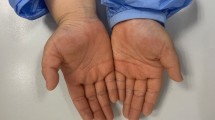Abstract
Allergic rhinitis (AR) is a type I hypersensitivity reaction of the nasal mucosa, primarily mediated by IgE, with a complex etiology, determined by genetic and environmental interactions. Several mechanisms by which AR affect middle ear and cause conductive hearing loss have been well described. There is paucity of data regarding involvement of inner ear in AR patients leading to sensorineural hearing loss. However, endolymphatic sac and outer hair cells have been hypothesized to be the seat of immunoreactivity. To study the audiological profile in AR and effect of AR on inner ear functions. 100 cases of AR patients (55 males, 45 females, mean age group 21–30 years) and 100 controls (65 males, 35 females, mean age group 41–50 years) were enrolled in study. All underwent thorough clinical ear, nose and throat examination, diagnostic nasal endoscopy and otoendoscopy, followed by audiological assessment including pure tone audiometry, tympanometry and oto-acoustic emission test. Hearing results of both the groups were compared and analysed statistically. Thirty two patients among case group had sensorineural hearing loss, pronounced at 4000 and 8000 Hz frequencies. 18 patients showed conductive hearing loss in the form of type B or type C tympanogram. 32 patients of AR patients showed unusual oto-acoustic emission test. We found higher prevalence of high frequency sensorineural hearing loss in pure tone audiometry and abnormal OAEs in patients having upper airway allergy. The likely seat of damage appears to be the inner ear as evidenced by recordings of OAE in allergic patients.




Similar content being viewed by others
References
Leynaert B, Neukirch F, Demoly P, Bousquet J (2000) Epidemiologic evidence for asthma and allergic rhinitis comorbidity. J Allergy Clin Immunol 106:S201–S205
Bosquet J, Van Cauwenberge P, Khaltaev N (2001) ARIA workshop group, WHO. J Allergy Clin Immunol 108:147–334
Lieberman P (2001) Treatment update: nonallergic rhinitis. Allergy Asthma Proc 22:199–202
Bahana SL (1992) Factors determining development of allergy in infants. Allergy Proc 13:21–25
Holgate ST (1997) Asthma genetics-waiting to exhale. Nat Genet 15:227–239
Hopp RJ, Bewtra AK, Watt GD (1984) Genetic analysis of allergic disease in twins. J Allergy Clin Immunol 73:265–270
Johansson SGO, Bieber T, Dahl R et al (2004) Revised nomenclature for allergy for global use: report of the nomenclature review committee of the world allergy organizanation. J Allergy Clin Immunol 2003(113):832–836
David P (2000) Skoner. J Allergy Clin Immunol 105:S605–S609
Klausen O, Moller P, Holmefjord A et al (2000) Lasting effects of otitis media with effusion on language skills and listening performance. Acta Otolaryngol 543:73–76
Altermatt HJ, Gebbers JO, Mullar C (1990) Human endolymphatic sac: evidence for a role in inner ear immune defence. ORL J Otorhinolarygol Relat Spec 52:143–148
Watson WT, Becker AB, Simons FE (1993) Treatment of allergic rhinitis with intranasal corticosteroids in patients with mild asthma: effect on lower airway responsiveness. J Allergy Clin Immunol. 91(1 Pt 1):97–101
Meltzer EO, Grant JA (1999) Impact of cetirizine on the burden of allergic rhinitis. Ann Allergy Asthma Immunol 83(5):455–463
Nayak AS (2003) The asthma and allergic rhinitis link. Allergy Asthma Proc. 24(6):395–402
Kiyohara C, Tanaka K, Miyake Y (2008) Genetic susceptibility to atopic dermatitis. Allergol Int. 57(1):39–56
Fireman P (1997) Otitis media and eustachian tube dysfunction: connection to allergic rhinitis. J Allergy Clin Immunol. 99(2):S787–S797
McColley SA, Carroll JL, Curtis S, Loughlin GM, Sampson HA (1997) High prevalence of allergic sensitization in children with habitual snoring and obstructive sleep apnea. Chest 111(1):170–173
Harris JP (1984) Immunology of inner ear: evidence of local antibody production. Ann Otol Rhinol Laryngol 93:157–162
Sekhon GS et al (2019) Int J Otorhinolaryngol Head Neck Surg 5(6):1451–1456
Singh S, Nagarkar AN, Bansal S, Vir D, Gupta AK (2011) Audiological manifestations allergic rhinitis. J Laryngol Otol 125:906–910
Karabulut H, Acar B, Dagli M, Karadag AS, Baysal S, Karasen RM (2011) Investigation of hearing in patients with allergic rhinitis. Iran J Allergy Asthma Immunol 10:29–33
Adeyemo A, Eziyi J, Amusa Y, Ameye S (2017) Hearing profile in children with allergic rhinitis. Adv Arab Acad Audio-Vestibul J 4:10–13
Fasunla AJ, Nwaorgu OGB (2011) Adult Chronic Rhinosinusitis: spectrum of clinical features and management in a tertiary health institution and literature review. Eastearn Center Afr J Surg 16:4–8
Mane S et al (2016) Effects of allergic rhinitis on middle ear ventilation: a tympanometric study. Natl J Med Dent Res 4(3):149–152
Dwarakanath VM, Shambhu T, Jayanna VJ (2019) Assessment of hearing in individuals with allergic rhinitis. Indian J Otol 25:117–120
Nursoy M et al. Audiological findings in pediatric perineal allergic rhinitis (house dust mite allergy) patients. European Archives of Oto-Rhino-Laryngology: Official Journal of the European Federation of Oto-Rhino-Laryngological Societies (EUFOS): affiliated with the German Society for Oto-Rhino-Laryngology—Head and Neck Surgery. 271. https://doi.org/10.1007/s00405-013-2628-4
Funding
None.
Author information
Authors and Affiliations
Corresponding author
Ethics declarations
Conflict of interest
The authors declare that they have no conflict of interests.
Additional information
Publisher's Note
Springer Nature remains neutral with regard to jurisdictional claims in published maps and institutional affiliations.
Rights and permissions
About this article
Cite this article
Sahni, D., Verma, P., Bhagat, S. et al. Hearing Assessment in Patients of Allergic Rhinitis: A Study on 200 Subjects. Indian J Otolaryngol Head Neck Surg 74 (Suppl 1), 125–131 (2022). https://doi.org/10.1007/s12070-020-01890-1
Received:
Accepted:
Published:
Issue Date:
DOI: https://doi.org/10.1007/s12070-020-01890-1




